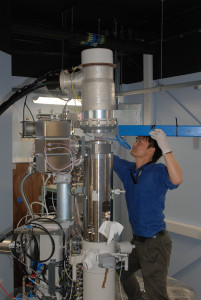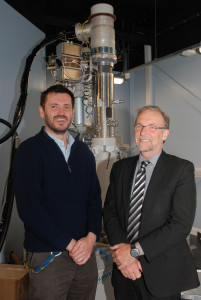MIAMI-2 – a leading centre for the study of radiation damage in materials
MIAMI-2 has established the University of Huddersfield as one of the world’s leading centres for the use of ion beams as a tool for the investigation of issues ranging from nuclear technology and nanoparticles to semiconductors and the effects of radiation exposure on materials in space.

Europe has three transmission electron microscopes with in-situ ion beam research facilities and two of them are in Huddersfield. The first of which was MIAMI-1 – standing for Microscope and Ion Accelerator for Materials Investigations – designed and built by Professor Steve Donnelly, Professor Jakob van den Berg and Dr Jonathan Hinks.


MIAMI-1 is a bespoke combination of a 100 keV ion accelerator with a 200 keV electron microscope enabling nanoscale investigation of radiation damage. Now it has now been joined by the more powerful, versatile and much larger MIAMI-2 which has dual ion-beams and greatly-enhanced analytical capabilities.
The Engineering and Physical Sciences Research Council (EPSRC) awarded £3.5 million for the development and construction of MIAMI-2, which has required the construction of a new storey at the laboratory complex in which it is now housed on campus.
Designed and constructed in collaboration with major companies such as, Hitachi and National Electrostatics Corporation – which have contributed major components – MIAMI-2 is already operational and will have its official launch in 2018.
Demand is high to use MIAMI-2 and will increase even further now that the University of Huddersfield has become one of the three UK universities to form the UK National Ion Beam Centre (UKNIBC) funded to the tune of £8.8 million – again by EPSRC.
The MIAMI-2 team consists of six members of academic staff plus two PhD researchers – rising to four in September with more studentships being advertised – and is currently mastering the complex new facility and its exceptional potential.
MIAMI-1 allows researchers to observe radiation damage on the nanoscale as it is happening but now MIAMI-2 brings additional capabilities in terms of analytical techniques. This means that they can irradiate, observe and analyse all at the same time generating a huge volume of invaluable scientific data in a very efficient manner.
Although scientists from elsewhere in the UK and overseas are already making extensive use of MIAMI-2, the University of Huddersfield’s own researchers will also take full advantage of the facility.
Currently, the largest area of activity at Huddersfield is nuclear technology with projects and international collaborations on both structural materials for reactors and solutions for waste storage. However, this group of researchers have historically worked with semiconductors and among the range of projects in which they are currently engaged are two PhD students studying nanowires and other types of nanoparticles. A further area of research is materials that have been in space or which are going into space; the hope is to understand the impact of the radiation they are exposed to and to develop a greater understanding of the history of the cosmos.

Spotlight
MIAMI (Microscopes and Ion Accelerators
The MIAMI (Microscopes and Ion Accelerators for Materials Investigations) facilities are a unique group of instruments combining ion irradiation with transmission electron microscopy (TEM). Constructed with funding from the UK’s Engineering and Physical Sciences Research Council (EPSRC), it is the only such centre in the UK and one of only two in Europe – the other being the JANNuS laboratory at Orsay in France. MIAMI-1, installed at the University of Huddersfield in 2011, can irradiate samples in-situ with inert gas ions in the energy range of 2–100 keV. The brand new MIAMI-2 facility is capable of irradiating samples in-situ with up to 350 keV ions whilst simultaneously irradiating with up to 20 keV H or He ions. These systems offer unique opportunities for investigations into the effects of energetic particles on materials as they allow the observation and recording of dynamic processes occurring under ion irradiation rather than just the end states. In addition, they permit control of the temperature of specimens under observation enabling materials to be studied at temperatures from –173 to 1300°C. For more information visit: MIAMI
Summer 2017 Issue
Return to the home page for the Summer 2017 Issue of Discover.
Next article
The past decade has seen a concentration of disaster events causing major social, economic and financial impacts. In order to tackle these...